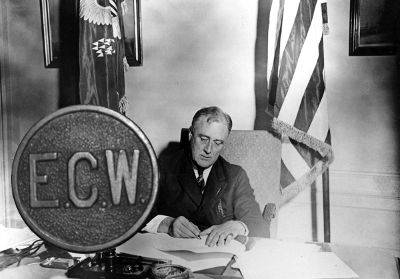Category: Event Date: 1933-03-31
ECW Act

Note Correction Below:
The CCC was created on March 31, 1933 by the Emergency Conservation Work Act and put into action by President Roosevelt with Executive Order No. 6101 on April 5, 1933.
The purpose of the ECW Act was to create work opportunities that would not interfere with normal employment and were specifically directed toward conservation of natural resources. With this rather vague goal, Roosevelt appointed Robert Fechner as the Director of the ECW to organize the existing four departments into an Advisory Council for the ECW and establish tasks for each department. The Labor Department oversaw the recruitment with stations set up in counties across the nation. The local Labor Department made the selection of the recruits until 1939, when that function was taken over by the federal Labor Department. The War Department administered the camps, physical training, transportation, and camp construction. The Agriculture and Interior Departments were in charge of finding work projects for the men that emphasized natural resource conservation. By using the strengths of each of the agencies, Roosevelt was able to develop a program without stigma of a military forced labor camp or competition with employed men. Only 37 days after signing the executive order, the first enrollee was signed on, and by July 1933, 250,000 boys were enrolled.
This is taken from: Region 6: Historical and Architectural Assessment of the Depression Era Work Projects, prepared by Lou Ann Speulda with contributions by Rhoda Owen Lewis, 2003.
Correction - Note this sentence above: "Only 37 days after signing the executive order, the first enrollee was signed on, and by July 1933, 250,000 boys were enrolled."
This goes back to the 37 day quote that NACCCA used over and over again in many resources. After the signing of Executive Order 6101 on April 5, 1933, and Henry Rich's enrollment on April 7, 1933, only two days elapsed. Only 34 days elapsed between FDR's inauguration and Henry Rich's enrollment. Using a date-to-date online calculator the only combination of dates that results in 37 days is from April 5 - May 12, 1933. This is the time between Executive Order 6101 being signed and FDR's directive to speed up mobilization and allow war vets. Has nothing to do with the time of FDR’s inaugural address and the first enrollee (Henry Rich) signing up. Conclusion: NACCCA had the beginning and ending dates of the 37 days tied to the wrong events.
Thank you Martha Smith for the update.
The Emergency Conservation Work Act and put into action by President Roosevelt.






